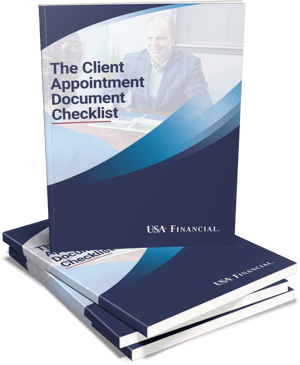Jul 20
2023
Practice Management,
Wealth Management,
Relationship Management

Repeated success does not happen by accident. It is achieved by using consistent processes. Have you ever looked back at a missed opportunity with a prospective client and said to yourself “I should have done this…” Advisors who follow a consistent, documented client acquisition process rarely find themselves making that statement.

Your appointment process should be like a recipe. Think about that for a moment. A recipe has two main components: the ingredients and the steps. Follow the recipe and you’ll get your desired outcome, more often than not.
Below are the 13 main ingredients of the recipe we use at USA Financial through our Appointment Protocol process:
First impressions are long lasting. The introduction kit sets the stage for the relationship and provides a great opportunity for you to create professional contrast right out of the gates. Typically, the introduction kit will be a professionally designed pocket-style folder that includes inserts revealing your process, information about the firm, and a short bio on the individual(s) with whom the prospect may interact initially. In addition, we encourage a personalized handwritten card along with an introductory letter that is paperclipped on the outside of the introduction kit. This letter will explain what to expect during the first meeting and beyond.
Prospective clients expect that they will need to share information with you at some point. They are used to this sort of process with most professionals. Our firm has a version of this document, which we have named the “Personal Asset Manager.” (Hint: name your fact finder something catchy). Best practice is to not send this in the introduction kit, but rather to use as a resource by the advisor or to be filled out by the prospective client at a later point in the process.

In this episode of The Rare Advisor, Aaron Grady and Allan Oehrlein dive deep into two essential tools for modern advisory practices: the service matrix and the stewardship framework. Discover why moving from a reactive to a proactive service model is critical for consistency, scalability, and client advocacy. Learn how these frameworks help advisors deliver predictable, high-touch experiences, segment clients effectively, and create professional contrast that sets your firm apart. If you want to elevate your client experience and build loyalty that lasts, this conversation is packed with actionable insights.

As 2025 comes to a close, the S&P 500 is up nearly 18% for the year—but what does that mean for your portfolio? In this December Trending Report, Kevin Roskam breaks down the year’s market performance, the role of trending strategies, and why diversification by time and philosophy matters more than ever. Learn how unemotional, disciplined investing helps you navigate volatility and stay focused on long-term success.

What if you could track an index, customize your portfolio, and reduce taxes - all at once? That’s the goal of direct indexing, a strategy gaining traction among advisors and investors alike.

In this episode of The Rare Advisor, Aaron Grady and Allan Oehrlein dive deep into two essential tools for modern advisory practices: the service matrix and the stewardship framework. Discover why moving from a reactive to a proactive service model is critical for consistency, scalability, and client advocacy. Learn how these frameworks help advisors deliver predictable, high-touch experiences, segment clients effectively, and create professional contrast that sets your firm apart. If you want to elevate your client experience and build loyalty that lasts, this conversation is packed with actionable insights.

As 2025 comes to a close, the S&P 500 is up nearly 18% for the year—but what does that mean for your portfolio? In this December Trending Report, Kevin Roskam breaks down the year’s market performance, the role of trending strategies, and why diversification by time and philosophy matters more than ever. Learn how unemotional, disciplined investing helps you navigate volatility and stay focused on long-term success.

What if you could track an index, customize your portfolio, and reduce taxes - all at once? That’s the goal of direct indexing, a strategy gaining traction among advisors and investors alike.